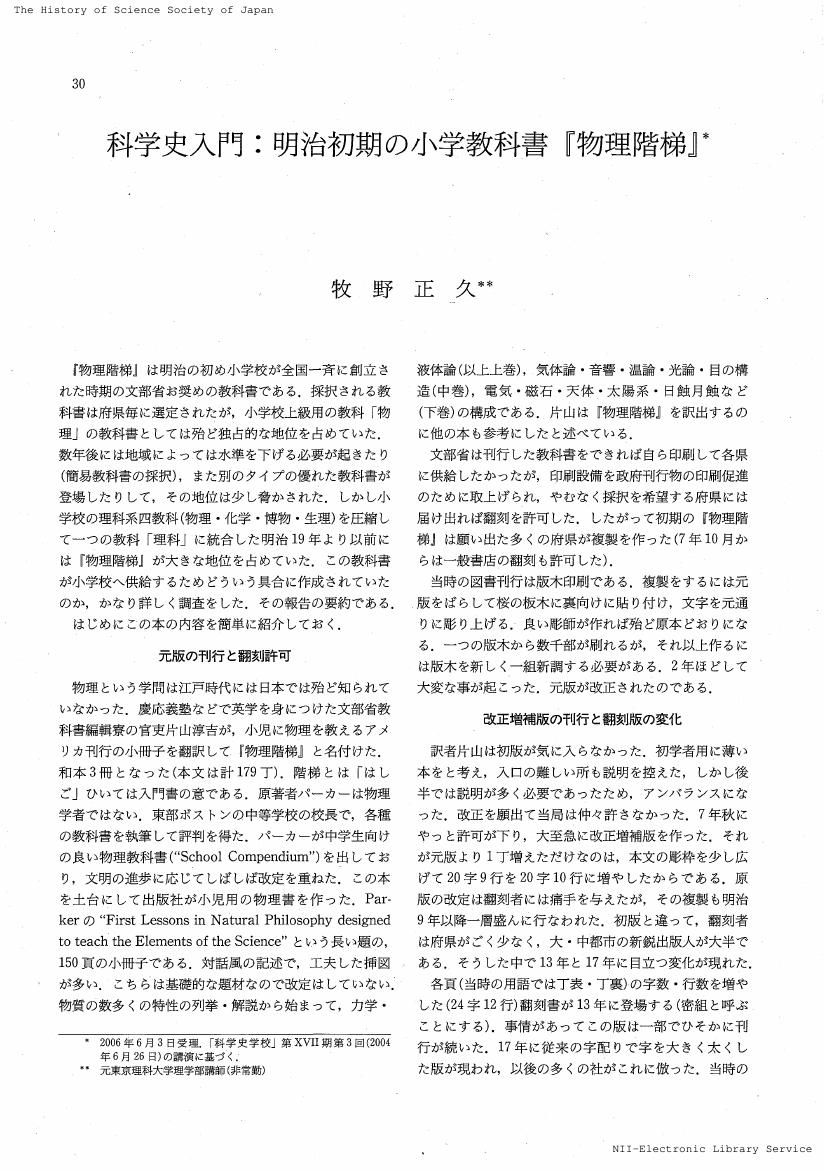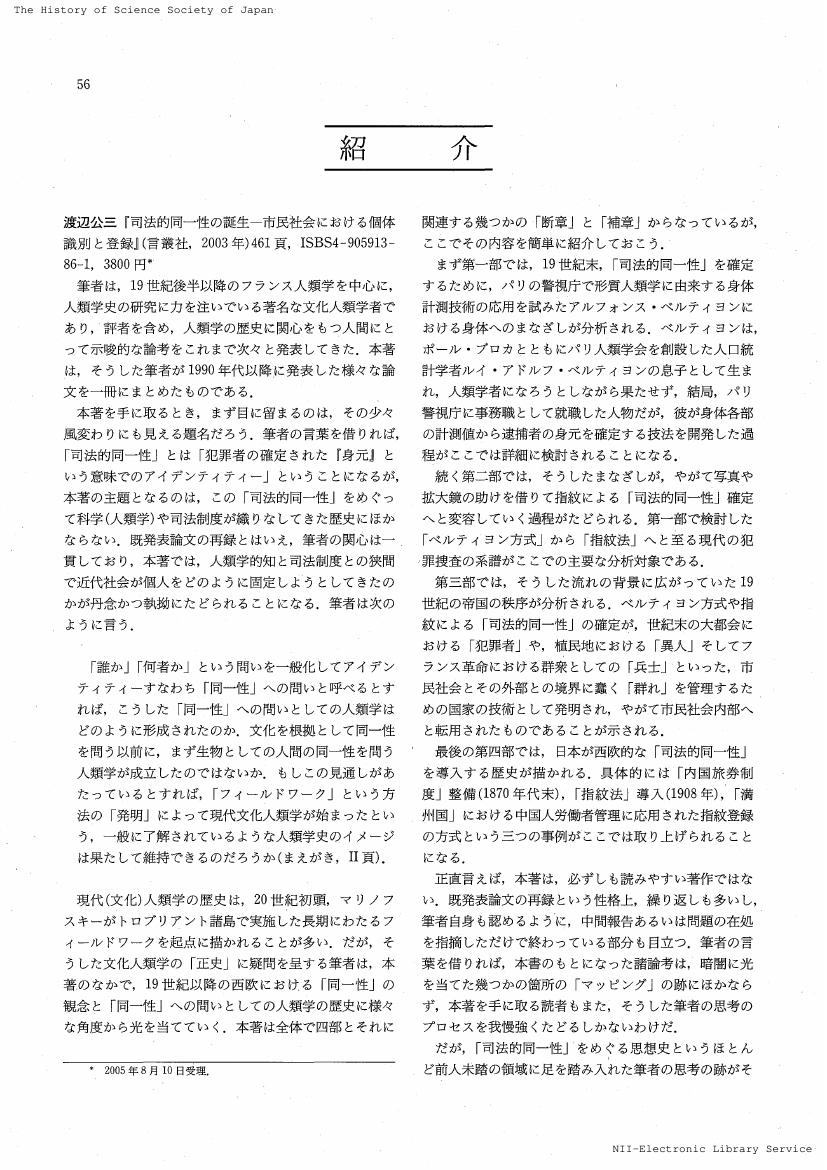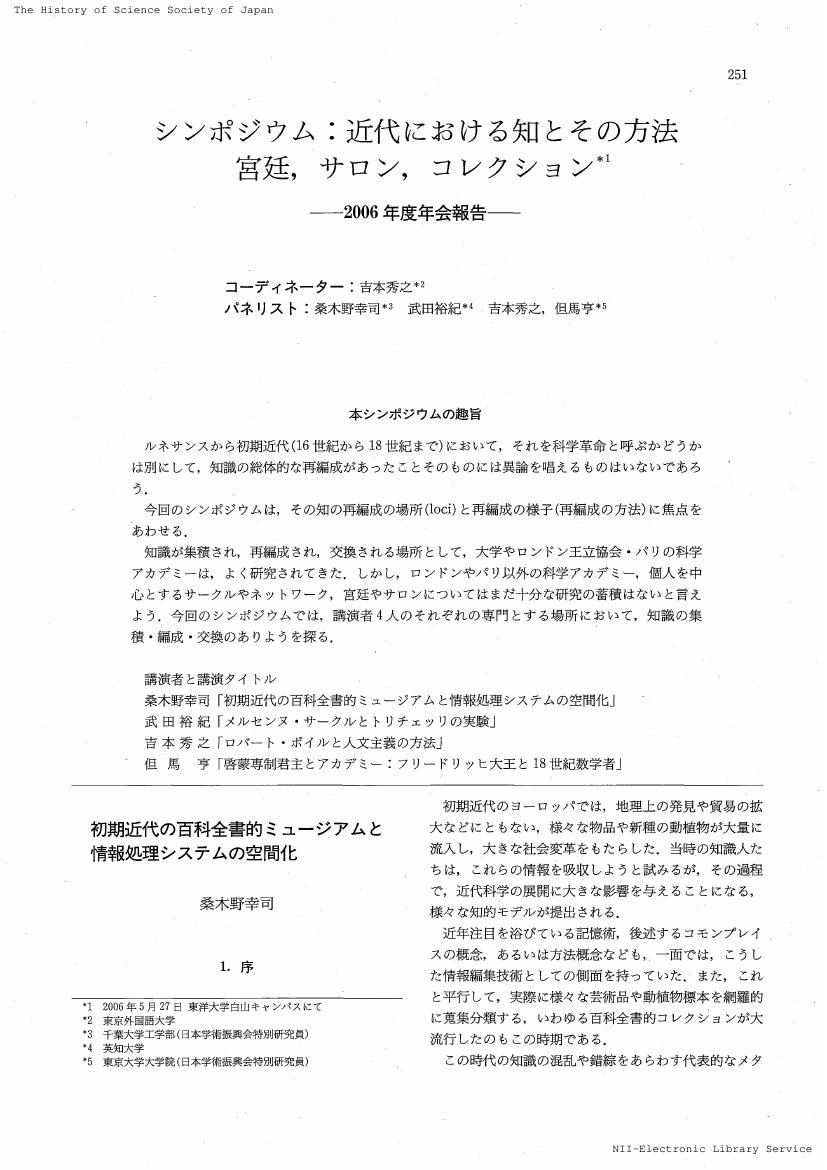1 0 0 0 OA C. E.シャノンによる情報量概念の導入について : 通信理論と暗号理論の分析を通じて
- 著者
- 杉本 舞
- 出版者
- 日本科学史学会
- 雑誌
- 科学史研究 (ISSN:21887535)
- 巻号頁・発行日
- vol.46, no.243, pp.145-154, 2007 (Released:2021-08-09)
C. E. Shannon formalized the concept of "the amount of information " and presented its formula H=-Σ^n_<i=1> p_i log p_i in 1940s, mainly in his paper "A Mathematical Theory of Communication ". His way of study had two progressive characteristics. Firstly, Shannon applied probability theory into his measure of information, which is more mathematically abstract and fruitful than those formalized by his precedent engineers, H.Nyquist and R.V.L.Hartley. By Shannon's expression it has been possible to measure "redundancy " and even "equivocation " which is the amount of lost information on the channel by using Bayesian probability. Secondly, Shannon regarded the discrete channel as the fundamental case and the continuous channel as its application, in spite of the fact that a continuous type was usually dealt as a basis at that time. In this point, his study of the cryptography affected his communication theory. In 1940s Shannon conducted researches on the communication theory as well as the cryptography simultaneously. Indeed "A Mathematical Theory of Communication " (1948) and his unpublished paper "The Mathematical Theory of Cryptography " (1945) have a lot of similar descriptions about the amount of information. Namely, Shannon's concept of information was influenced by both the preceding results on the communication theory and his own research on the cryptography. Boltzman's H formula seems to bear a close resemblance to Shannon's one, but any descriptions showing some direct relations between them have not been found.
1 0 0 0 OA 戦後日本における産業用計量標準供給体系の構築の歴史
- 著者
- 詫間 直樹
- 出版者
- 日本科学史学会
- 雑誌
- 科学史研究 (ISSN:21887535)
- 巻号頁・発行日
- vol.46, no.241, pp.14-24, 2007 (Released:2021-08-11)
In the 1990s, Japan undertook to improve its national measurement standards with a view to assisting the country's advanced R&D programs. I discussed in an earlier paper that this was achieved by the expansion of the notion of R&D infrastructure. This paper shows the importance of industrial measurement standards for corporate R&D, production and maintenance. The New Standard Code revised at the GATT Uruguay Round required the global harmonization of technical standards and conformity assessment procedures. This New Standard Code played a major role in the recognition of importance of industrial measurement standards dissemination system in Japan in the 1990s. This paper considers the establishment of industrial measurement standards dissemination system in Japan for over a period of 30 years. By doing so, we can obtain a rough pattern of evolution of the industrial measurement standards dissemination system : In the 1970s an attempt to imitate the American traceability system was made, but it proved futile. Then, in the 1980s a Japanese alternative traceability system began to take form. A full-fledged traceability system emerged only in the 1990s thanks to external pressures. This historical pattern connotes Japan's backwardness in establishing a measurement standards dissemination system.
1 0 0 0 OA 柔らかい強制-スターリン時代初期における科学思想の方向付けの一事例
- 著者
- 金山 浩司
- 出版者
- 日本科学史学会
- 雑誌
- 科学史研究 (ISSN:21887535)
- 巻号頁・発行日
- vol.46, no.241, pp.25-29, 2007 (Released:2021-08-11)
1 0 0 0 OA 明治初期の小学教科書『物理階梯』(科学史入門)
- 著者
- 牧野 正久
- 出版者
- 日本科学史学会
- 雑誌
- 科学史研究 (ISSN:21887535)
- 巻号頁・発行日
- vol.46, no.241, pp.30-34, 2007 (Released:2021-08-11)
1 0 0 0 OA シンポジウム:学術研究体制の改編と今後のあり方を考える-2006年度年会報告-
1 0 0 0 OA 紹介
- 出版者
- 日本科学史学会
- 雑誌
- 科学史研究 (ISSN:21887535)
- 巻号頁・発行日
- vol.46, no.241, pp.56-61, 2007 (Released:2021-08-11)
1 0 0 0 OA 写本『天文方書留』に見る南蛮・蘭学系天文学の混在
- 著者
- 平岡 隆二
- 出版者
- 日本科学史学会
- 雑誌
- 科学史研究 (ISSN:21887535)
- 巻号頁・発行日
- vol.46, no.242, pp.65-77, 2007 (Released:2021-08-11)
This paper discusses the content and characteristics of a hitherto unexamined manuscript Tenmongata kakitome (Astronomical Note), Isahaya City Library, Nagasaki. This anonymous and undated manuscript is a compilation of 83 short passages concerning mainly Western astronomy and geography. Although almost all the passages lack information about the sources from which they are taken, textual comparison clearly reveals that a half of them (41 passages) corresponds to the text of the Nigi ryakusetsu, a typical of Nanban astronomy books which originated from Jesuit missionary activities during the 'Christian century' in Japan (1549-1650). Moreover, the other passages contain much information relating to Rangaku (Dutch studies), such as Latin and Dutch texts with Japanese translations. Textual comparison reveals that some of them obviously correspond to those seen in the Nichigetsukei wage (Translation about the sundial and moondial) of Motoki Ryoei (1735 -1794), a famous Nagasaki interpreter of Dutch. These facts show that this compilation was completed later than the Tenmei era (1781-1788), probably around Nagasaki, by extracting and combining several texts of the two books as well as the other sources. In effect, the Tenmongata kakitome is not only a rare example which illuminates the transmission of these two books, but also provides the evidence that the two lines of circulation, i.e. those of Nanban and Rangaku astronomy, which were hitherto thought un-interrelated, certainly met each other at least later than the Tenmei era.
- 著者
- 今井 正浩
- 出版者
- 日本科学史学会
- 雑誌
- 科学史研究 (ISSN:21887535)
- 巻号頁・発行日
- vol.46, no.242, pp.78-90, 2007 (Released:2021-08-11)
The Hippocratic treatise De Vetere Medicina (On Ancient Medicine) has been the focus of attention among classical scholars and historians of medicine. The author attacks in ch. 20 doctors and sophists who base their own medical theories and methods on philosophical anthropology taken from the contemporary natural philosophers. Many attempts have been made to elucidate, as opposed to their philosophical inquiry into human nature, the author's way of understanding it, which still remains unclear. I draw attention to the following points to make it clear that the conceptual framework of the author's medical anthropology is different from theirs. Their philosophical inquiry into human nature has its starting point in fundamental element(s), from which human beings were originally formed. The author focuses on human beings as existent in their present states, whose conditions and functions must be investigated through interrelations between them and their external factors, such as foods and drinks. A medical investigation into the interrelations will give us a scientific idea about human body, whose constituents are taken to be a large number of humors, reacting against some external factors and accordingly making us feel pain. This may presuppose that, in the author's medical anthropology, human body is conceptually demarcated as the physical or material aspect of human being, within which all physiological events depending on external factors and the humors take place. In their philosophical anthropology, however, human body doesn't seem to have been clearly conceptualized as such, because our experience of feeling pain should be judged to take place within the actions of the fundamental element(s), which must be supposed to constitute our cognitive self.
1 0 0 0 OA 第53回日本科学史学会年会・総会報告
- 出版者
- 日本科学史学会
- 雑誌
- 科学史研究 (ISSN:21887535)
- 巻号頁・発行日
- vol.45, no.240, pp.245-250, 2006 (Released:2021-08-11)
1 0 0 0 OA シンポジウム:近代における知とその方法宮廷,サロン,コレクション-2006年度年会報告-
1 0 0 0 OA 紹介
- 出版者
- 日本科学史学会
- 雑誌
- 科学史研究 (ISSN:21887535)
- 巻号頁・発行日
- vol.45, no.240, pp.265, 2006 (Released:2021-08-11)
1 0 0 0 OA 戸坂潤の『全集』未収録文献22編の発見(アゴラ)
- 著者
- 北林 雅洋
- 出版者
- 日本科学史学会
- 雑誌
- 科学史研究 (ISSN:21887535)
- 巻号頁・発行日
- vol.45, no.239, pp.189-190, 2006 (Released:2021-08-11)
1 0 0 0 OA 第22回国際科学史会議での日本からの報告(続々)
1 0 0 0 OA 紹介
- 出版者
- 日本科学史学会
- 雑誌
- 科学史研究 (ISSN:21887535)
- 巻号頁・発行日
- vol.45, no.239, pp.204-205, 2006 (Released:2021-08-11)
1 0 0 0 OA オイラーの変分力学
- 著者
- 有賀 暢迪
- 出版者
- 日本科学史学会
- 雑誌
- 科学史研究 (ISSN:21887535)
- 巻号頁・発行日
- vol.45, no.240, pp.220-228, 2006 (Released:2021-08-11)
Although newtonian mechanics is the most familiar formulation of classical mechanics, we have an another one called variational mechanics. Leonhard Euler attempted to solve some mechanical problems using the latter idea and gave two variational-mechanical laws : "law of rest " in statics, and "law of motion " in dynamics. He maintained that these two laws were "in harmony ", namely that the one could be derived from the other. Moreover, they are both based on "principle of least action, " according to which some quantities are minimum in physical phenomena. In effect, "law of rest " asserts that the sum of "efforts " for bodies is minimum in equilibrium, which Euler interprets as the evidence of the intention of nature to "save efforts. " "Law of motion " determines the trajectory of a mass point, in which "action " is minimum; according to Euler, this could be explained by the inertia of bodies. These laws show Euler's faith in his principle, even though he doesn't use the condition of "minimum " in solving concrete problems; therefore, his "principle of least action " is not a mathmatical requirement. His demonstration of the "harmony " is also based on the belief that nature "saves efforts. " This attempt is, however, a failure in a double meaning; we can't prove the "harmony " from the point of modern view, and Euler's proof is inconsistent with his own "principle of least action. " "Euler's variational mechanics " has failed to realize a unified treatment of statics and dynamics, because it was built up on the "principle of least action. "
1 0 0 0 OA 1890年代の熱輻射分布法則導出におけるパッシェンの実験研究の先導的役割
- 著者
- 小長谷 大介
- 出版者
- 日本科学史学会
- 雑誌
- 科学史研究 (ISSN:21887535)
- 巻号頁・発行日
- vol.45, no.240, pp.229-240, 2006 (Released:2021-08-11)
This paper examines the process and development of revolutionary data of thermal radiation in the late 19th century, focusing on Friedrich Paschen's experimental research in the early to mid-1890s. The well-known experiments of O. Lummer and E. Pringsheim, H. Rubens and F. Kurlbaum had brought about the suggestive results concerning Planck's radiation law. Paschen's research played an important role in pioneering experimentalists who were active in the early 1890s. Before Lummer, Pringsheim, Rubens, and Kurlbaum made a series of experiments on the radiation law, Paschen had begun to research on the "Normal Spectrum " representing the spectral distribution of radiation energy. He had made it to examine the spectrum of diffraction grating with the directions of H. Kayser in 1891-1892. In the meantime, other experimentalists such as Lummer and Rubens conducted research on the measurements of luminous intensity and electricity at the request of refining the standards. In 1893 Paschen improved the foundation for experiments on thermal radiation by utilizing those different kinds of measurements and made a step forward in the precision measurements of radiation distribution function.
1 0 0 0 OA 知的財産権と技術発展(科学史入門)
- 著者
- 名和 小太郎
- 出版者
- 日本科学史学会
- 雑誌
- 科学史研究 (ISSN:21887535)
- 巻号頁・発行日
- vol.45, no.240, pp.241-244, 2006 (Released:2021-08-11)
1 0 0 0 OA 日本の近代化と物理実験機器(科学史入門)
- 著者
- 永平 幸雄
- 出版者
- 日本科学史学会
- 雑誌
- 科学史研究 (ISSN:21887535)
- 巻号頁・発行日
- vol.45, no.238, pp.99-102, 2006 (Released:2021-08-11)
1 0 0 0 OA 技術の内的発展法則論と歴史の法則性(アゴラ)
- 著者
- 山崎 正勝
- 出版者
- 日本科学史学会
- 雑誌
- 科学史研究 (ISSN:21887535)
- 巻号頁・発行日
- vol.45, no.238, pp.103-104, 2006 (Released:2021-08-11)













